As one of the most critically acclaimed films of both the 2010s and writer/director Paul Schrader’s career, First Reformed (2017) is a treasure trove of analysis-worthy material. Along with being a fantastic and thought-provoking film, First Reformed represents what might be the ultimate synthesis of themes and influences that Schrader has fixated on throughout his career.
*Content warning for mentions of suicide throughout*
The film stars Ethan Hawke as Reverend Ernst Toller, a preacher at a dying historic church in upstate New York. Toller is keeping a diary where he vows to write frankly about himself for one year before burning the book. Much of the film is voiceover narration of these diary entries. We learn through the course of the narrative that Toller’s only son was killed in Iraq after joining the military at Toller’s urging, which summarily ended his marriage. He is also in poor health (likely stomach cancer) and is an alcoholic, which is an obviously awful combination that leads to things like drinking whiskey with Pepto-Bismol in it.
One day, one of the few remaining congregants, Mary (Amanda Seyfried), approaches him after the service. She is worried about her husband Michael (Philip Ettinger), an environmental activist who has grown increasingly despondent about the state of the climate crisis. Mary is several months pregnant, and Michael wants her to consider getting an abortion because he doesn’t want to bring a child into a world that is dying. When Toller meets with him, Michael poses the question that serves as the idée fixe of the rest of the movie: “Can God forgive us for what we’ve done to this world?” Although it is unclear how much the meeting helped Michael, the pair commit to meet again.
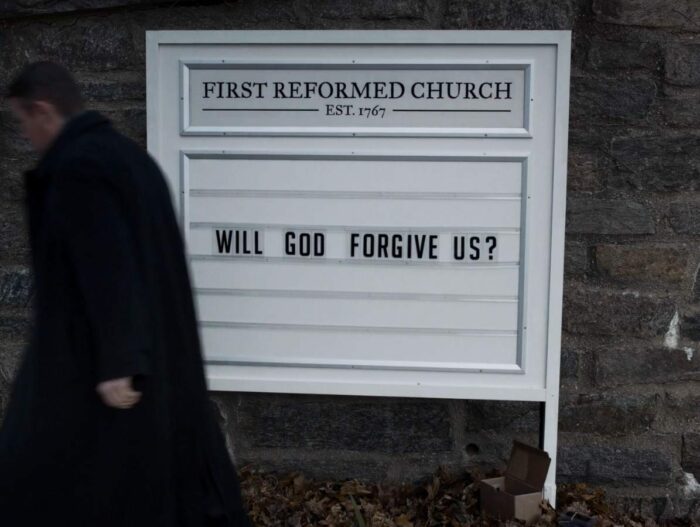
One day while Michael is at work, Mary asks Toller to come over to show him a suicide vest she found in the garage. Toller takes the vest away with him and tells Mary not to tell the police. The next day, Toller gets a text from Michael asking to meet him in a park. When he arrives, he discovers Michael’s body.
After the police notify Mary of Michael’s suicide, Toller takes Michael’s laptop to prevent them from discovering Michael’s intended ecoterrorism. He discovers Michael’s will, which requests that his ashes be scattered at a heavily polluted waste site. Toller leads Michael’s memorial at the site, and the youth choir of another church sings a Neil Young protest song. The lyrics seem to subtly trigger something within him: “who’s gonna stand up and save the Earth?” Toller begins to read the research on Michael’s computer, becoming increasingly disturbed at what he is learning.
Meanwhile, the church’s 250th anniversary reconsecration service is looming. The service is piling additional stress on Toller, as well as creating tension between him and the pastor of a local megachurch, Joel Jeffers (Cedric the Entertainer). Rev. Jeffers’ Abundant Life church funds Toller’s First Reformed church and is planning the reconsecration, which is going to be attended by VIPs like the governor and industrialist Ed Balq.
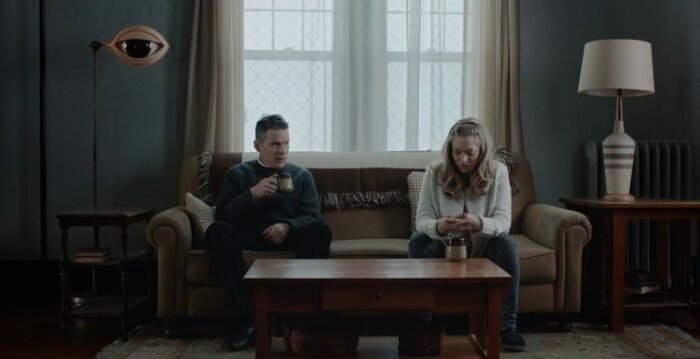
Balq is underwriting the reconsecration service. Much like Jeffers’ Abundant Life, which says all the right things to be viewed as a church even though it’s more of a corporation, Balq’s company says all the right things to be considered environmentally friendly while actually being a major polluter. Toller meets with Balq and Jeffers at a diner and the two clash over Michael’s memorial service.
Through everything, Toller becomes increasingly radicalized and physically sick. It soon becomes evident that he is planning to detonate the vest at the reconsecration service. When the day arrives, he is prepared to go through with it until he sees Mary arrive at the church. He screams, takes off the vest, and wraps barbed wire around his body in a seemingly grotesque parody of a crown of thorns. Toller throws out his liquour, but then pours drain cleaner into his glass to drink and kill himself. As he is raising the glass to his lips, he hears Mary call out to him by his first name—the only time it is spoken in the whole film. She is standing in the house. Toller throws away the drain cleaner, the two embrace and passionately kiss, and the film cuts to black.
First Reformed, Mishima, and Beauty

Schrader is easily one of my favorite filmmakers to listen to on commentary tracks. He is invariably insightful about inspiration, interpretation, and craft, while still leaving enough room for the viewer to have their own interpretations. In the first moments of the First Reformed commentary track, Schrader is open that First Reformed is an unofficial remake rip-off homage to Ingmar Bergman’s Winter Light and Robert Bresson’s Diary of a Country Priest.
While a lot of the discussion regarding the film focuses on its combination of these two European films with Taxi Driver, very little is even said by Schrader himself about its thematic connections to another of his fantastic films, 1985’s Mishima: A Life in Four Chapters. This is understandable since Taxi Driver is one of the most famous movies of all time and Mishima more of an arthouse cult classic, but that doesn’t erase the importance of Mishima to the later work.
Mishima is a biography of controversial Japanese author Yukio Mishima. The film presents various aspects of his life: his upbringing (shot in black-and-white), his final day (shot in color), and scenes from three of his books. The mini-adaptations of his books are, in my opinion, the most spellbinding part of the film due to their hyper-stylized sets, bright color palette, and stagings reminiscent of noh theater.
Mishima and Toller share many similarities: they are both men that epitomize Schrader’s famous “man in a room” archetype, express their increasingly radical inclinations through writing, and are driven to—and in Mishima’s case, past—the brink of suicide in what would be overtly political acts. Their actions, words, and world views often mirror one another; for example, as Mishima dresses himself before he initiates the coup attempt that would end his life, his voiceover states “Recently I’ve sensed an accumulation of many things which cannot be expressed by an objective form like the novel. Words are insufficient. So I found another form of expression.” Toller, who has been unable to pray, almost exactly echos Mishima’s words by simply stating “I have found another form of prayer.”
One of the novels that Schrader adapted in Mishima was The Temple of the Golden Pavilion, which he uses to examine Mishima’s views on beauty and aesthetics. The book—which is loosely based on real events—is about a young acolyte with a debilitating stutter named Mizoguchi, who burns down the temple where he serves. In Mishima, Mizoguchi is obsessed with the beauty of the temple to the point that he can barely function when he’s in its vicinity.
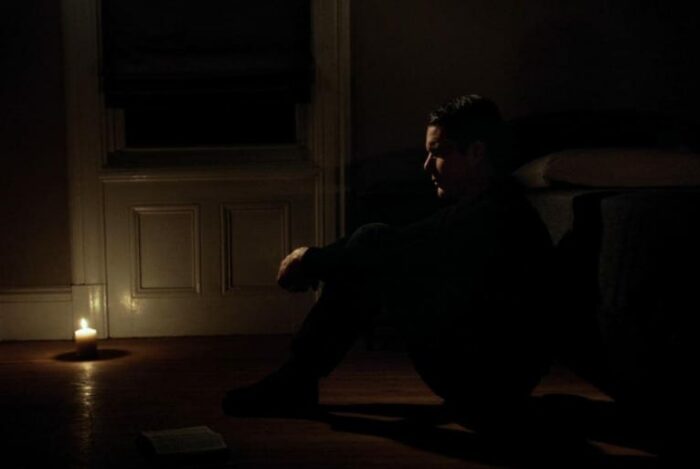
The temple isn’t the only thing that Mizoguchi finds unbearably beautiful; at one point, right before he is about to lose his virginity, he is distracted by the beauty of the woman he is with to the point of immobilization, all under the watchful eye of the temple. At first, he can’t even look at her as he removes her blouse, and his hand shakes as he hesitates over her breast. The woman is turned off by his odd behavior and leaves him. Afterwards, he is talking to his friend Kashiwagi about the incident, saying “It was as small as this [holding a miniature Golden Pavilion], but grew so big. It filled the world like tremendous music. That’s the power of beauty’s eternity. It poisons us. It blocks out our lives.” Kashiwagi responds that “Beauty is like a rotten tooth. It rubs against your tongue, hurting, insisting on its importance. Finally, you go to a dentist and have it pulled. Then you look at the small bloody tooth in your hand and say, ‘Is that all it was?’”
It is at this point that Mizoguchi decides that he cannot allow his obsession with the temple—and by extension beauty itself—to dominate his life, declaring “Beauty is now my enemy. Life is bearable only when I imagine the Golden Pavilion has been destroyed. Then, I’ll be free.” As Mizoguchi speaks, he crushes the miniature replica in his hands, foreshadowing the real temple’s eventual destruction, once again by his hands.
While I haven’t read the original novel that this vignette is based on, there is another adaptation of The Temple of the Golden Pavilion that I have seen: the 1958 film Conflagration. In this film, the Golden Pavilion’s similarities to First Reformed are even more evident. Mizoguchi is a borderline zealot in Conflagration: he is fanatically protective of the temple, to the point where he doesn’t allow his own mother into it for protection during an air raid and at one point pushes down a pregnant woman who is attempting to enter the temple, resulting in a miscarriage. It is more than an obsession with the temple’s beauty: Mizoguchi is protective of the temple to extreme and unhealthy lengths.
Compounding the Conflagration version of Mizoguchi’s angst is the erosion of trust he feels for the temple’s master. Mizoguchi is disillusioned by the master, who uses the temple as a tourist attraction to raise funds and keeps an apartment for his mistress. When Mizoguchi takes out a loan that he is unable (and unwilling) to repay and gets blackmailed by the woman he pushed, the master is forced to pay money on Mizoguchi’s behalf to avoid a scandal. These mistakes worsen Mizoguchi’s rift with the master, who had once viewed him as a potential successor. Mizoguchi’s destruction of the temple is at least partially meant to purify it from this corrupting force. Even though these external corrupting forces are de-emphasized in Mishima, Schrader’s Mizoguchi still utters a line that resonates across all three movies: “The Golden Pavilion…who’ll set it free?”
Similarly, Toller’s church is a relic of the past that has been reduced to a (struggling) tourist location and, as Jeffers puts it, “gift shop.” The congregation is virtually non-existent and the tourists are patronizing and uninterested. To add insult to injury, the church is being kept afloat by someone Toller (correctly) views as evil; Balq and people like him are corruptly and greedily destroying the earth for profit. This incredibly important point that I don’t think gets enough attention: Toller’s goal in planning to bomb the church isn’t exclusively to assassinate a governor, a profiteering mega-church pastor, and an industrial polluter destroying the planet; like Mizoguchi, Toller wants to destroy the church/temple because he believes that it is better off destroyed than continually corrupted by greed and hypocrisy. I might even go as far as to say that the church is the true target of his bombing, more so than any individual.
First Reformed and Transcendental Style
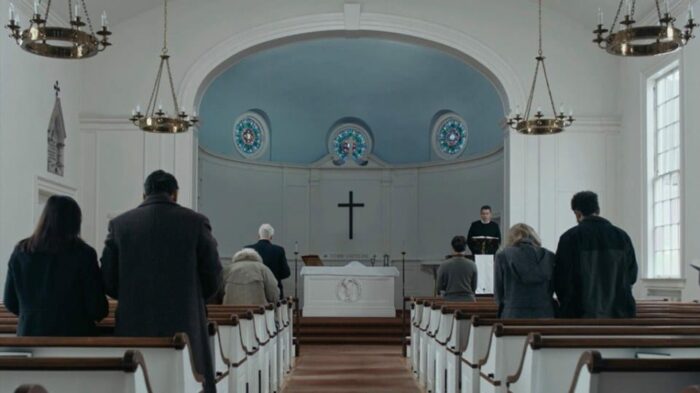
Along with being a prolific screenwriter and director, Schrader started his career as a critic. He also wrote a book called Transcendental Style in Film: Ozu, Bresson, Dreyer in 1972. This book, the research he did for it, the films he covers in it, and the thought processes he examines in it, represent what could be the single biggest influence not only on First Reformed, but Schrader’s entire artistic career. As he was with the influences he borrowed from for the film, Schrader is upfront from the outset of the film’s audio commentary that he made First Reformed with the explicit intent to make a transcendental-style film.
As the title suggests, Schrader viewed Yasujirō Ozu and Robert Bresson as exemplars of transcendental style (Carl Theodor Dreyer was to a lesser extent), which Schrader explains is “a universal form, which is used by different film-makers in divergent cultures in order to express the Wholly Other.” [2]. Of course, this definition may raise the question “what is the Transcendent?” and “what is the Wholly Other?” Schrader says that the Transcendent is “beyond normal sense experience, and that which it transcends is, by definition, the immanent” [3].
Schrader identifies a very particular form and very specific techniques that these three filmmakers used to express the holy. Formally, transcendental style films follow a pattern of moving through what Schrader calls the everyday (“a meticulous representation of the dull, banal commonplaces of everyday living”), disparity (“an actual or potential disunity between man and his environment which culminates in a decisive action), and finally stasis (“a frozen view of life which does not resolve the disparity but transcends it”) [4].
These three steps manifest themselves very clearly in First Reformed. At the beginning of the film, Toller is going about his daily life. There isn’t anything particularly exceptional going on outside of his health and newly begun journal. We see him go about his everyday life, which is banal despite Toller’s already present isolation and self-destructiveness.
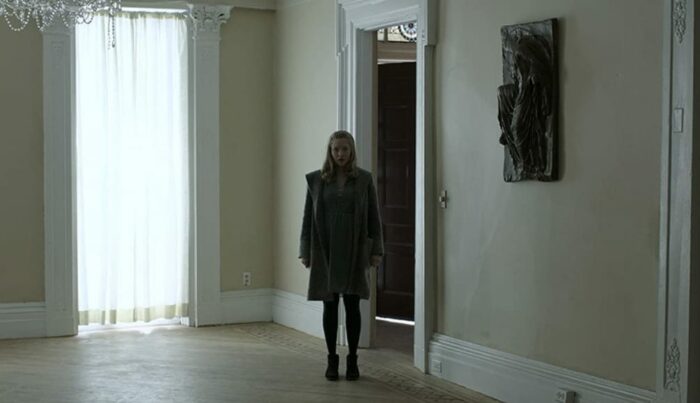
There isn’t anything out of the ordinary that results from Toller’s initial interactions with Mary and Michael until the discovery of the suicide vest. The disunity lies in Toller’s decision to cover up Michael’s planned domestic terrorism, rather than report it to the police, since as a priest, he obviously ought not to be engaging in ecoterrorism. This moment is his first step down the path of fully embracing ecoterrorism himself. The discovery of the vest sets in motion the rest of the film, including Michael’s suicide, which kicks the disparity into high gear.
According to Schrader, disparity culminates in a “decisive action.” Schrader states that “the ‘growing crack in the dull surface of everyday reality’ becomes an open rupture, and finally, in the moment of decisive action, there is an outburst of spiritual emotion totally inexplicable within the everyday” [5]. In some cases, such as Dreyer’s Ordet, which Schrader admits inspired the ending for the film, the decisive action is an actual miracle [6]. Stasis is the expression of the transcendent. Schrader describes the moment stasis is triggered by saying “the decisive action does not resolve disparity, but freezes it into stasis. To the transcending mind, man and nature may be perpetually locked in conflict, but they are paradoxically one and the same.”
In First Reformed, this moment is the sudden appearance of Mary just as Toller is going to kill himself by drinking drain cleaner (or rather presumably before he kills himself, as Schrader has admitted to tweaking the edit to make Toller’s survival ambiguous). Mary’s appearance, which is itself miraculous since it was established that the door was locked, results in this outpouring of emotion from both Toller and Mary, and they kiss for almost a full minute. The camera twirls around them in the most extended and extensive camera motion in the whole film, which to this point has featured almost exclusively static shots. Despite the suddenly active camera, their kiss is the final stage of transcendental style, stasis. Nothing else matters during this moment, nor does anything that happened before or after—there is only one perfect moment. As Schrader puts it, “heaven looks like one long kiss.”

Throughout the book, Schrader identifies several techniques to distance the audience from the narrative, facilitating the final turn towards transcendence. These techniques give the audience space to make their own interpretations and deprive them of the emotion they’re accustomed to in more mainstream films. Filmmakers working within the transcendental style do so “by delaying edits, not moving the camera, forswearing music cues, not employing coverage, and heightening the mundane,” which results in “a sense of unease the viewer must resolve.
All of these techniques figure extensively in First Reformed. Schrader takes deprivation to incredible levels, including stripping most of the furnishings from the sets, most notably Toller’s absurdly spartan home which contains a large central room, containing a single chair and nothing else. However, the small moments when he decides to—as he calls it in the commentary—“break the rules” are just as interesting. These moments are typically subtle camera moves and uses of music that, in a normal context, would be unexceptional; however, these techniques have a different impact when the audience has been denied them for the entire movie. For example, the film features very little music until Toller begins to research climate change for himself. The music that enters isn’t exceptional or noteworthy, it’s simply a low, ominous drone, but the near-complete absence of any music before that moment makes the sudden appearance of music stand out. When these elements return during the final stasis, the effect on the audience is compounded.
While a single movie can’t summarize a director’s entire career any more than a biopic can represent its subject’s entire life, First Reformed comes about as close as it can to synthesizing Schrader’s career. This essay represents only a fraction of the analytical opportunities offered by the film’s rich and multi-level narrative. To plug Schrader’s commentary track one more time, it is an excellent starting point for anyone interested in learning about a film that has quickly become one of my favorites.
[1] This is much ado about nothing, but when I first watched the film I had a wild conspiracy theory that Mary actually killed Michael instead of him committing suicide. Maybe not cold-heartedly, it could have been self-defense. I don’t really subscribe to this theory anymore, but part of me still hangs on to it.
[2] Paul Schrader, Transcendental Style in Film: Ozu, Bresson, Dreyer (Oakland, CA: University of California Press, 2018), ebook.
[3] Ibid.
[4] Ibid.
[5] Ibid.
[6] Ibid.

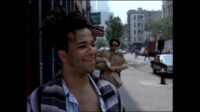

thank you,good job!
Wow! Thank you for helping me understand, so much better, how the style of the film conveys so much of its meaning.